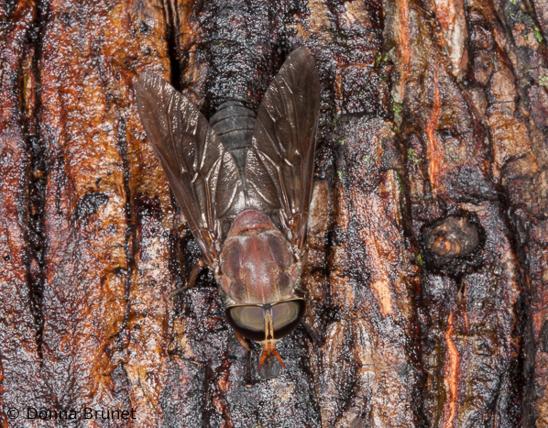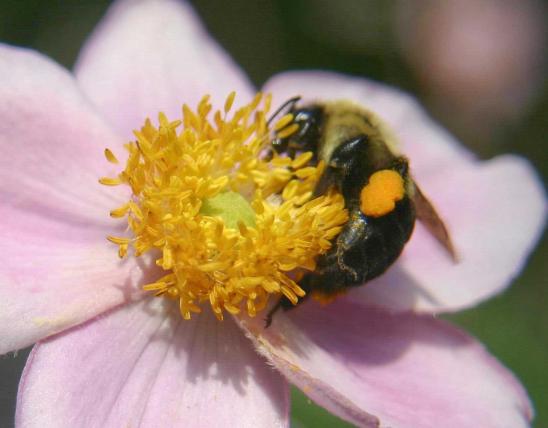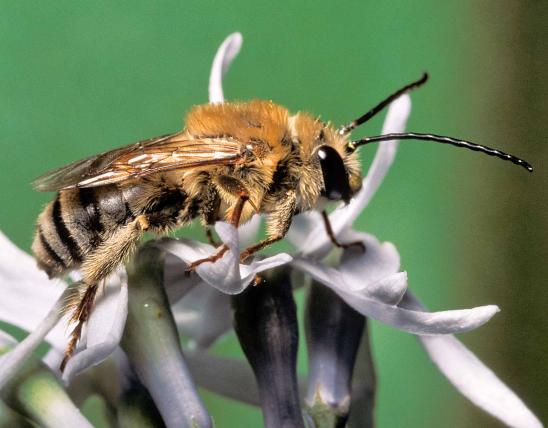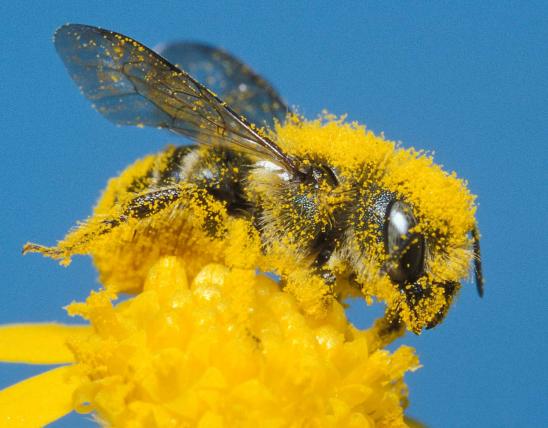
Bot flies are chunky, beelike flies usually with rounded heads. Adults are not commonly seen. The larvae are short, pudgy, segmented grubs that live as parasites in the tissues of animals. Those that live just under the skin often form a bulge (called a warble); typically, there’s a small hole in the center of the welt through which the larva’s breathing tubes extrude. The larvae of some types of bot flies live in the nasal cavities of deer; others inhabit the digestive tracts of horses, under the skin of cattle, and so on. One large group parasitizes rodents and rabbits.
As with other true flies, bot flies have only a single pair of wings. Other tips for recognizing them as true flies (and not the bees they mimic) include tiny antennae, large eyes, and a pair of knobby structures (halteres) where the second pair of wings would be.
Some common Missouri bot flies include:
- Deer bot flies, or deer nose botflies (Cephenemyia spp.), 5 species in North America. Adults are bumble bee mimics. Females flick newly hatched larvae into the nostrils of deer or elk. The larvae move through the sinuses into the throat and at the base of the tongue, where they burrow into the tissues and develop. When mature, they leave the host and pupate in soil. The species C. phobifer, whose name translates to “fearsome deer botfly,” is apparently the most common representative in our area.
- Rodent and lagomorph bot flies (Cuterebra spp.), about 25 species in North America. Oval flies about the size of bumble bees. Parasitize rodents and rabbits. Females deposit eggs in the tunnels or burrows of their required hosts. The eggs hatch when the warm body of a likely host brushes by, and the larva grabs on. They burrow head-first into the skin of the host, eating the flesh, causing a bulging, tumorlike “goose egg” on the surface of the host. Small, snorkel-like anal spiracles protrude from the hole in the skin, allowing the larva to breathe. They are certainly not good for their hosts, but they rarely cause death.
- Horse bot flies (Gasterophilus spp.) include 4 species native to Europe that now occur worldwide. Adults resemble honey bees. They mostly parasitize horses, mules, and donkeys. They usually deposit eggs onto the fur of the host, which then bites or licks the fur, ingesting the parasites. The different species develop in different parts of the host: the stomach, the rectum, the intestines, the throat, and so on. When mature, they usually exit the host along with the feces. Once on the ground, they exit the manure and burrow into the soil to pupate. These can be serious parasites of horses. Horse bot flies have been known to occasionally infect people, and those who work with horses in summer should avoid rubbing their eyes after combing or washing animals and be sure to wash their hands well after handling horses.
- The sheep nasal bot fly (Oestrus ovis) and the common cattle grub (Hypoderma lineatum) are bot flies that afflict the livestock species indicated by their names.
Similar species: As adults, the various types of bot flies may be confused with several kinds of flying insects, including other groups of true flies as well as the various groups of bees they all mimic. Among the true flies that might be confused with bot flies are bee flies, flower flies, deer flies, tachinid flies, and robber flies. Then there are the many groups of true bees that these flies mimic: bumble bees, apid bees, andrenid bees, megachilid bees, longhorn bees, and more.
Adult length: about 1 inch. Varies by species.
Statewide.
Habitat and Conservation
Adult bot flies are less commonly encountered than the grublike larvae. Adult male bot flies often are attracted to high points in a landscape, which helps them find females (males of many kinds of insects do this, including several types of butterflies; it’s called “hilltopping”).
Adult bot flies are usually most common where their host species are common. Horse bot flies, for example, tend to congregate around horse stables and pastures, especially in midsummer and fall.
Hunters processing their game frequently discover the pudgy larvae of deer nasal bot flies in the heads or body cavities of deer and elk.
Food
Adults have reduced or absent mouthparts and generally do not eat at all.
Bot flies typically do all their eating in the larval stages, as internal parasites of mammals. Different types of bot flies focus on certain types of mammals, and different species grow in different parts of their host’s body: some growing under the skin, some in the gut, some in nasal or throat passages, and so on.
Status
Larvae are parasites that burrow into and develop within the tissues of their mammalian hosts. Unless numerous parasites are present, they usually do not seriously harm or kill their hosts.
Adults do not have functional mouthparts and do not eat. Many resemble bees, but they are incapable of stinging.
If you think you are your livestock or pets are parasitized by bot flies, seek medical attention.
Bot fly larvae in harvested deer or other game are not harmful to humans.
Current understanding of the bot fly family is that it comprises a number of subfamilies that used to be considered separate families. If you look at older references, you may see the horse bot flies and robust bot flies listed separately from the rest of the bot and warble flies.
Life Cycle
Adult bot flies do not live very long, as they are incapable of eating. Their primary job, at this stage of life, is to reproduce. In many bot fly species, the fertilized eggs hatch within the mother’s body, and she ejects the young larvae into rodent burrows, deer nostrils, or whatever the target host is. In other species, the unhatched eggs are distributed in like manner.
When the larvae find themselves within a suitable host, they make their way to the targeted tissues and burrow in. When their feeding is complete and they’re ready to pupate, they usually leave the host and pupate in the soil.
Human Connections
Nose botflies (Cephenemyia spp.), commonly seen in deer as hunters process their game, cannot harm people. There is no known risk to humans. Meat from affected animals is safe for human consumption.
Bot flies can parasitize several species of livestock. Where bot flies are numerous, they can be serious pests of livestock. In large numbers, and varying with the species, the parasitic larvae can injure livestock, interfere with proper nutrition, or impede breathing. Also, large numbers of adult bot flies can distress livestock with their incessant attacks around the nose and mouth. Consult your veterinarian for advice on how to handle infestations.
There is a species of bot fly that routinely parasitizes humans, but relax; it is not found in Missouri. The human botfly (Dermatobia hominis) is a tropical species that occurs from southern Mexico south into most of South America. It does not visit humans directly; instead, the female human botfly sticks her eggs to the body of a mosquito or a tick, and the eggs or newly hatched young are transferred to their intended host when the mosquito or tick visits a person. Because the bot larva secretes antibiotic chemicals, the wound it causes rarely becomes seriously infected, and people usually fare surprisingly well if they don’t kill the insect. (Killing the larva while it’s in one’s flesh typically causes an infection.) Understandably, many people opt for medical removal of the bot. For an unforgettable account of a field biologist’s, um, hair-raising adventure with a human botfly, read the chapter “Jerry’s Maggot” in Adrian Forsyth and Ken Miyata, Tropical Nature: Life and Death in the Rain Forests of Central and South America.
Miasis is the name for the condition of having fly maggots (of whatever type) living in a living animal’s body. It’s most common in tropical regions, but in North America, livestock and pets can be afflicted when flies (of a variety of types, including blow flies or bottle flies, bot flies, and flesh flies) lay eggs on the host. Often, they are attracted to open wounds or moist, protected parts of the body dirty with urine or fecal material (such as the rear ends of sheep or other livestock).
Bot fly larvae have been eaten by humans for thousands of years in places where other protein may be hard to come by, including by the Inuit, who commonly find caribou warble fly larvae in the caribou they have hunted.
Ecosystem Connections
Many animals parasitized by bot flies show no external sign of infection. Nasal bots may cause minor nasal discharge. In severe infestations, the parasites may interfere with the host’s ability to gain nutrition (stomach or intestinal bots) or to breathe (nasal or throat bots that can suffocate the host).
Long ago, a claim was made that bot flies could fly 800 miles per hour, but that is clearly incorrect. Bot flies can, however, fly at speeds of up to 25 or 50 miles per hour, making them some of the faster insect fliers. Hawk moths (or sphinx moths) can fly about 33 miles per hour, and a horse fly was recorded flying nearly 90 miles per hour. Dragonflies can fly about 25 miles per hour.
We humans are horrified by parasites, but as a way of life, parasitism is much less violent than outright predation. The parasitized host usually lives to see another day, and most of us would rather serve as dinner to a bot fly or leech than to a wolf or mountain lion. Bot fly larvae often secret antibiotic chemicals as they feed, reducing the chance of infection (which is self-serving for the parasite, as an infection could cause its own death).
Many types of flies mimic bees. Bot flies aren’t even capable of biting, much less stinging. Resembling an insect that can deliver a painful sting is an effective defense against being troubled by potential predators. There’s an amazing array of insects, worldwide, that strongly resemble stinging bees and wasps. The black-and-yellow (or black-and-red) color pattern is understood by many, many animals as a sign of “I could sting you.” This sophisticated web of warning colorations (and bluffs!) is called a mimicry complex by biologists. Where the same warning signals (such as coloration or loud buzzing) is shared “honestly” among stinging insects, it’s termed Müllerian mimicry. It’s named after the biologist who described the concept: Whether the painful lesson comes from a bee or a wasp, a potential predator learns to avoid all yellow-and-black buzzy creatures. Each stinging species benefits from mimicking the same warning signal. Meanwhile, in cases where harmless species have adapted to copy the look of harmful species, basically fooling potential enemies into leaving them alone, it’s termed Batesian mimicry—again, after the biologist who proposed the idea. Thus adult bot flies are Batesian mimics of bees.
Despite their beelike appearance, many bot flies no doubt are eaten by a variety of predators ranging from spiders, robber flies, and mantids to birds, lizards, and more. Recall also that their defenseless pupae, resting in the soil, would be a nice snack for moles, shrews, salamanders, toads, skunks, ground snakes, and more. A bot fly larva living within the leg of a mouse will be bolted down by an owl along with the rest of the mouse.



































